Island hopping in Greece is an experience of a lifetime! The stunning scenery, crystal-clear waters, delicious food, and rich history and culture make for a fantastic trip. Here are all the tips you need to plan your Greek island-hopping trip entirely on your own.

How to travel between the Greek islands by ferry
Island hopping in Greece is a unique experience. From the amazing beaches to the picturesque villages and numerous ancient sites, there is so much to explore on each island.
With well over 100 beautiful islands to choose from, planning an island hopping trip to Greece might seem like a daunting task. In reality, though, it’s not that hard to plan your Greek vacation on your own.

I’m Vanessa from Athens, and I’ve been island-hopping in Greece since I was a kid. I’ve travelled to about 70 of the Greek islands, and I wrote this guide to help you plan your own island hopping trip in Greece. Here is my step-to-step guide and my best tips!
1. Research the best time of year to visit the Greek islands
Before you start planning to travel to the Greek islands, you should know that Greece has four seasons. In fact, winters in Greece can be surprisingly cold and damp. Most of the coastal resorts, even on world-famous islands like Santorini, actually shut down in winter!
The best months to visit the islands of Greece are from May to September, when the weather is warm and you can enjoy the beautiful beaches.
However, keep in mind that July and August are peak tourist season, and many islands will be crowded. If you’re looking for a calmer vacation, consider visiting in May, June or late September.
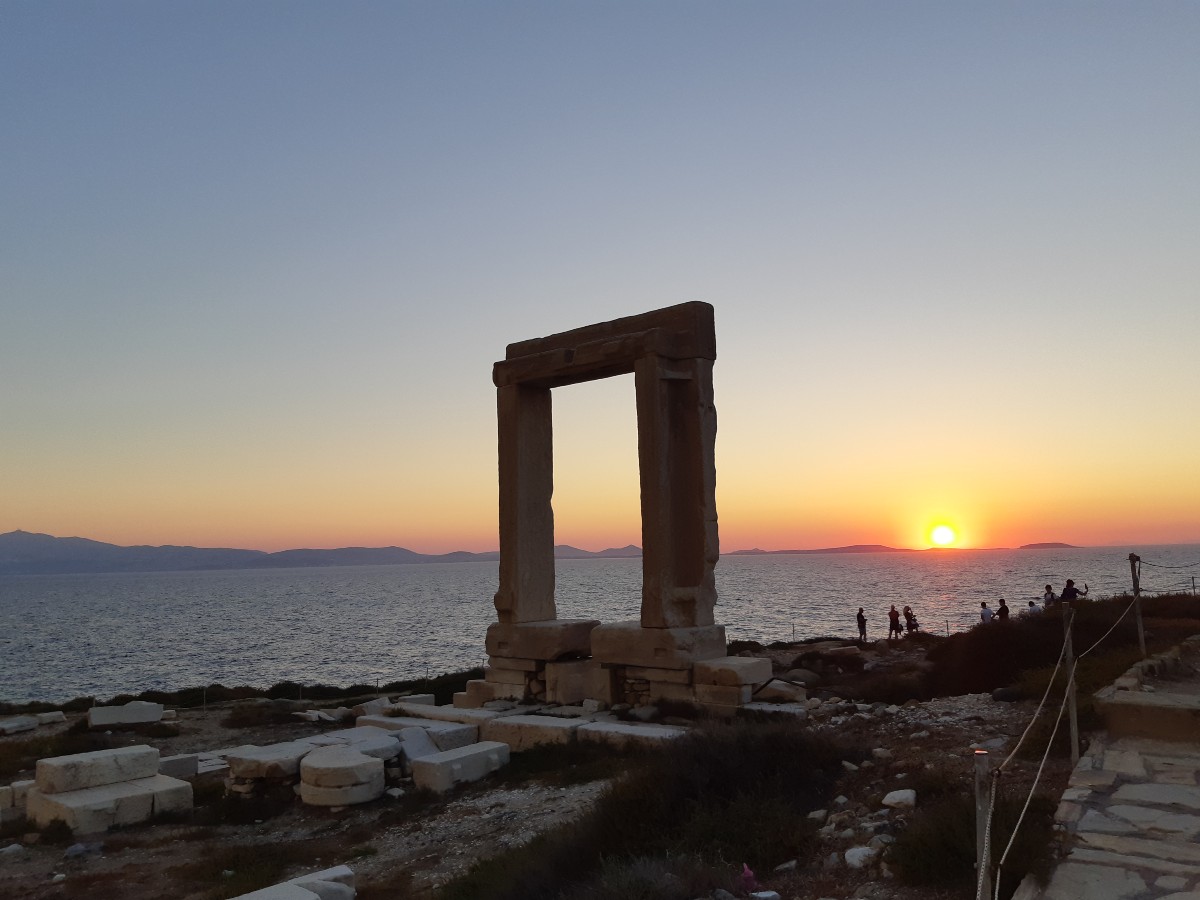
April and October are also good options, though the weather can be a little hit and miss. If you are looking to visit in April or early May, you could plan your trip around the Greek Orthodox Easter celebrations, which are very unique.
For some more insight, have a look at these articles:
2. Check a map of Greece and see where the islands are
As you are starting to plan your trip, look at a map of Greece. You will notice that most of the islands are clustered together in groups. The main Greek island groups are the following:
- Cyclades islands, known for their white-washed houses and dry, rocky landscapes. Mykonos, Santorini, Naxos, Milos and Paros belong to the Cycladic islands.
- Saronic islands, which are located close to Athens and are known for their cosmopolitan feel. Examples are Aegina, Hydra and Spetses.
- Sporades islands, known for their verdant landscapes. There are four islands in this group – Skiathos, Skopelos, Alonissos and Skyros.
- Dodecanese islands, which are the furthest away from Athens. Some of them are Rhodes, Kos, Symi, Tilos and Nisyros.
- Northern Aegean islands, some of the lesser known islands in Greece. Lesvos, Chios and Ikaria are some of the biggest ones.
- Ionian islands, which are known for their long sandy beaches and thick forests. Corfu, Kefalonia and Zakynthos are the most popular ones.
- Crete, Greece’s largest island, which is located to the south of the Greek mainland.
- Evia, a large island close to Athens, which you can reach via a bridge.
For more information on what each island group looks like, have a look at this introduction to the Greek island groups.
3. How to plan your Greek island itinerary
To plan your Greek island itinerary, research the islands and their attractions, allocate time for each island, plan accommodation and transportation, create a rough daily itinerary, and be flexible in case of unexpected changes.
That was easy, eh? Let’s break this down further!!
So, if you are like most people, you will have about one or two weeks to spend in Greece. In order to save time and avoid last-minute stress, it’s usually best to plan your itinerary in advance.
First, you will need to decide which islands you want to visit. While it can be an overwhelming task, it becomes a lot easier if you narrow them down by island group, or proximity on the map! Then, you can decide if you want to focus on the most touristy islands, or perhaps some small islands that you don’t know anything about.

As you are planning your itinerary, you will need to check transportation options between the islands. It’s much easier to visit islands that are directly connected to each other via ferry.
I use a search engine called Ferryscanner to check ferry routes and book my ferry tickets. Most ferry itineraries are released a few months in advance, so there’s plenty of time to plan.
You can also see past ferry routes on a site called Openseas. While exact routes may change from one year to the next, this will give you a pretty solid indication.
Find the best Greek island hopping routes
My best tip when island hopping in Greece, is to visit islands which are connected on direct ferries. Usually, these belong to the same island groups.
Some examples are:
- Santorini, Mykonos, Paros and Naxos
- Andros and Tinos
- Milos and Kimolos
- Rhodes, Nisyros and Kos
- Santorini and Crete
- Ithaca, Kefalonia and Zakynthos
- Corfu and Paxi.
While it may be tempting to visit islands in completely different island groups, you will find that the logistical challenges involved might not be worth it. For example, travelling from the Cyclades to the Ionian islands would require flights and / or ferry journeys of several hours.
Of course, it’s still possible to visit islands that are far from each other if that’s what you want. Just be prepared to allow for extra travel time, and note that transportation is likely to be costly.
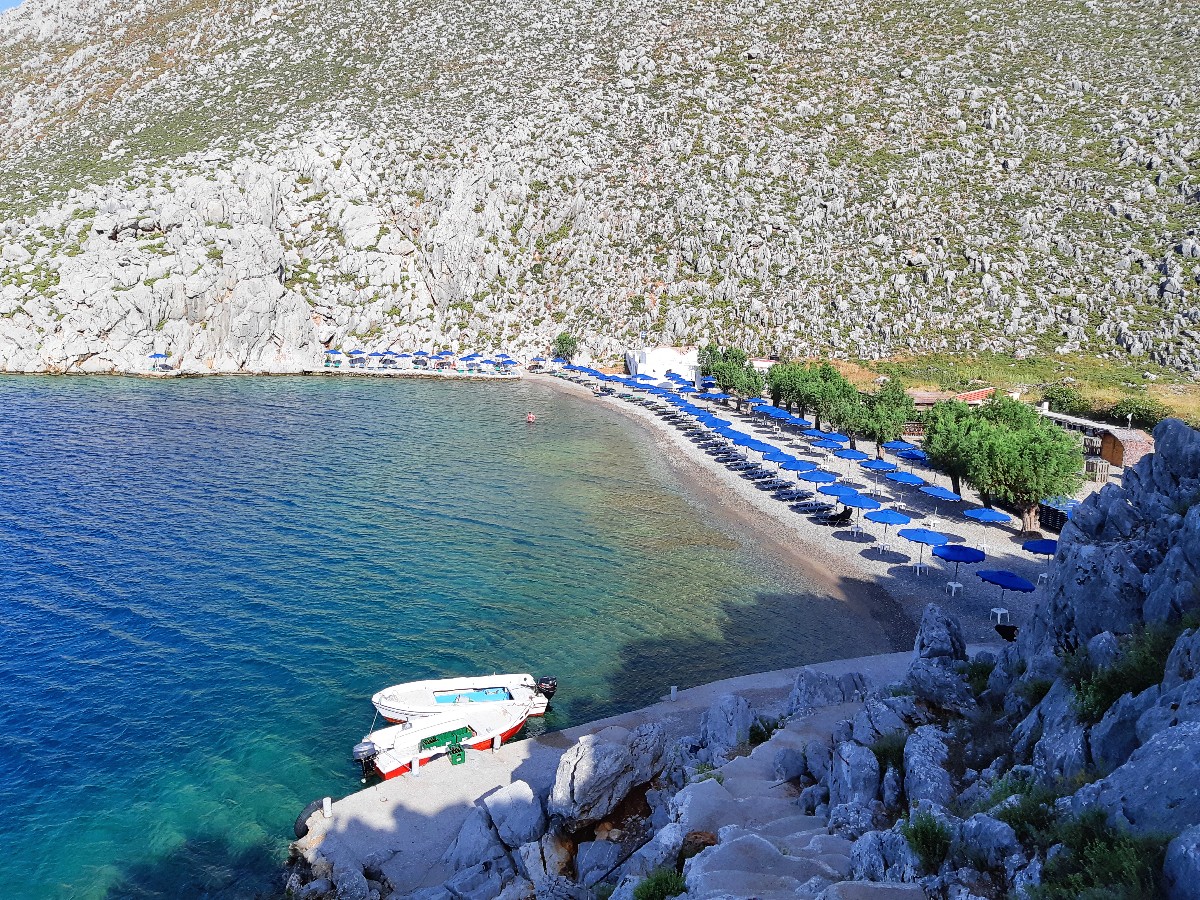
Allow enough time on each island
When you are planning your Greece trip, you will be tempted to try and visit several islands, especially since there are so many beautiful ones to choose from. However, more isn’t always better!
I recommend spending at least 3 nights on each island, and longer for larger islands. So, if you have 9-10 days in Greece, I would suggest that you visit no more than three islands.
It’s also important to factor in travel time between islands when planning your itinerary. Check the ferry schedules and travel times carefully, as they can vary depending on the season and the day of the week. And note that, occasionally, a ferry might get delayed – more on this, later.
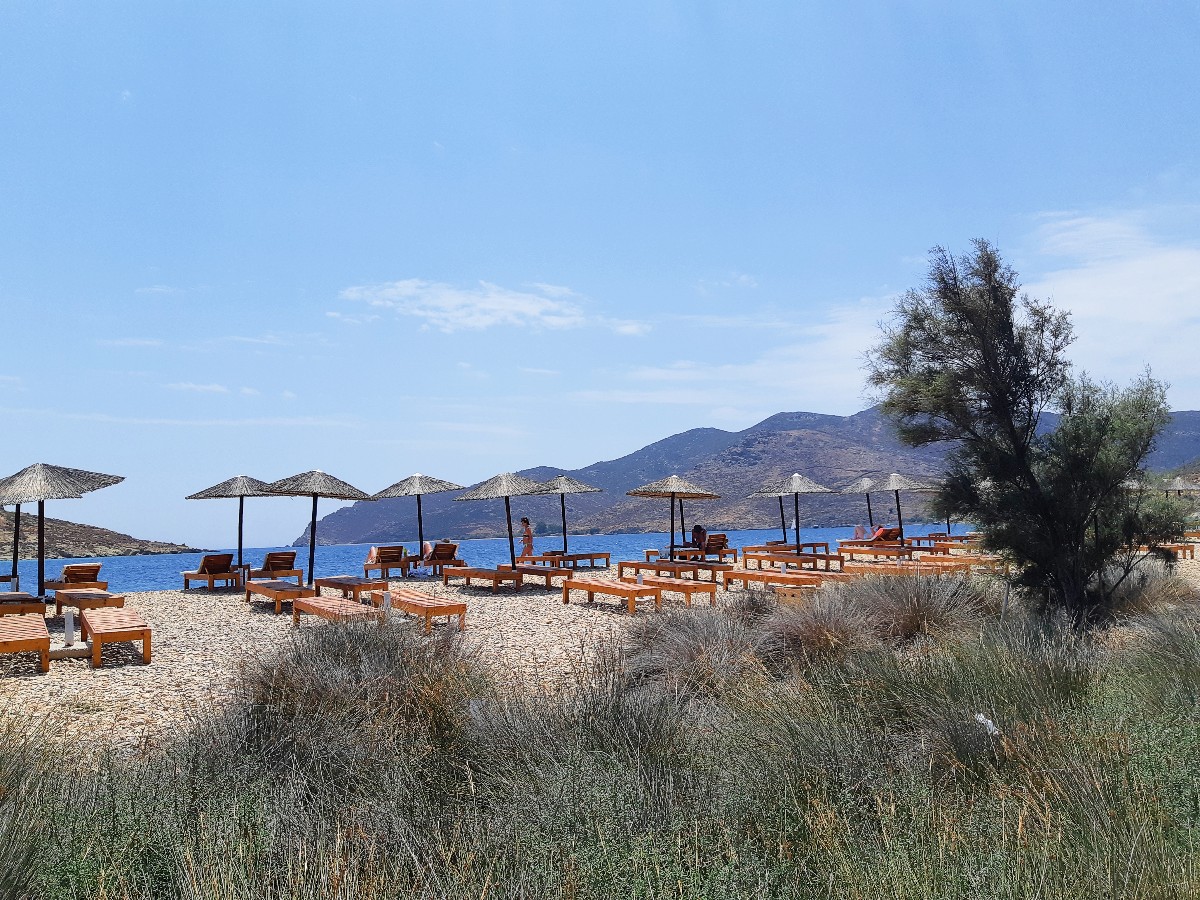
Allow enough time to see the sights, enjoy the gorgeous beaches and scenic landscapes, soak up the atmosphere, and fully immerse yourself in the local culture. This will help make your trip to Greece even more memorable!
4. Check flight options to Greece
Once you’ve got a rough plan in mind, you can check out available flight options to Greece and the islands. Many people fly into the Athens International Airport (ATH), the biggest airport in Greece.
However, several islands also have international airports. If you are flying from Europe, you may be able to find direct flights to major destinations in Greece such as Santorini, Mykonos, Crete, Rhodes, Kos, Kefalonia and Skiathos. These flights are usually available during late spring, summer and autumn.
In addition, several islands such as Naxos, Milos or Syros have domestic airports, and there are daily connections to and from the Athens airport year-round. So you can fly into Athens, and catch an onward flight a few hours later.
Have a look at my guide on all Greek islands with airports.
Once you’ve booked your flights, you can move on to the next step: book your accommodation!
5. Book your hotels on the Greek islands
Once you have planned your itinerary and decided which islands you want to visit and in what order, you can go ahead and book your accommodation on each one.
Accommodation options on the Greek islands can vary a lot. Some islands, like Mykonos or Santorini, will offer a range of luxury resorts and villas. Most islands also have more budget-friendly options like guesthouses or small family-run hotels.
I recommend booking your accommodation in advance, especially if you’re travelling during peak season. While there may be last-minute options available, they might not be suitable for your specific needs.
Also, keep in mind that many of the smaller islands, such as Schinoussa or Donoussa, have limited accommodation options. During the high season, rooms can actually get sold out, as there are many travellers who return every year. Make sure you check availability of accommodation before finalizing your itinerary.
I’ve always found that Booking.com offers more choice and better value in Greece than other similar platforms such as Airbnb or VRBO. So make sure you check all options before you book.

6. How to buy Greek ferry tickets
Once you have booked your accommodation, you can book your ferry tickets as well. As mentioned earlier, Ferryscanner is a useful search engine to check ferry routes and book your tickets.
Some travellers prefer to book their ferry tickets last minute. In my opinion, it’s usually best to book them at least a week or two in advance, especially during the peak tourist season when some ferries can actually sell out.
And while there will often be another ferry on the same day that you can take, it doesn’t hurt to secure the route you actually prefer!
A few tips on ferry travel in Greece
Ferries are the most common mode of transportation between the Greek islands. There is a huge network of ferries, some of which run year-round. Others are seasonal and run in spring, summer and autumn.
Itineraries for most ferries are announced a few months in advance – it depends on the individual ferry company.
The Greek ferry system is very efficient overall. Still, ferries can sometimes be delayed or, in rare cases, cancelled. Always allow for extra time when planning your ferry trip. If you are flying back home from Athens, I suggest spending your last evening in the Greek capital.
Keep in mind that ferries will typically be crowded during peak season. Get to the port at least a half hour early, especially if you don’t have a numbered seat – more on this below.
And finally, make sure to bring a light jacket on board. Some of those ferries have ridiculously cold air-condition!

Fast ferries vs slow ferries
Generally speaking, there are two types of ferries in Greece: the fast ferries and the slow ferries.
The fast ferries only have assigned indoor seating, and you are not allowed to walk on the outdoor deck. People often refer to all fast ferries as “SeaJets”, as the majority are run by a company called SeaJets.
Note that not all SeaJets are equal – in fact, they vary a lot in size. The smaller ones can be claustrophobic for some people, and are a no-no if you easily get seasick, as the meltemi summer winds will affect them. If you have a choice, it’s best to travel on the bigger SeaJets, that also carry vehicles on board.
Most of the slow ferries are bigger, and they have both an outdoor and an indoor area. They are generally more comfortable to travel on, even on windy days, and are also cheaper, especially if you get a deck (non-assigned) seat. Many of the most popular slow ferries travelling around the Aegean Sea are run by a company called Blue Star Ferries.
In any case, it’s a good idea to have some motion sickness medication with you, just in case. And if you are planning to sit on the deck, don’t forget your sunscreen and a hat. You won’t feel you are sunburned until you look at yourself in the mirror – I’ve learnt the hard way!
For more information, please refer to my complete guide packed with Greek ferry tips.
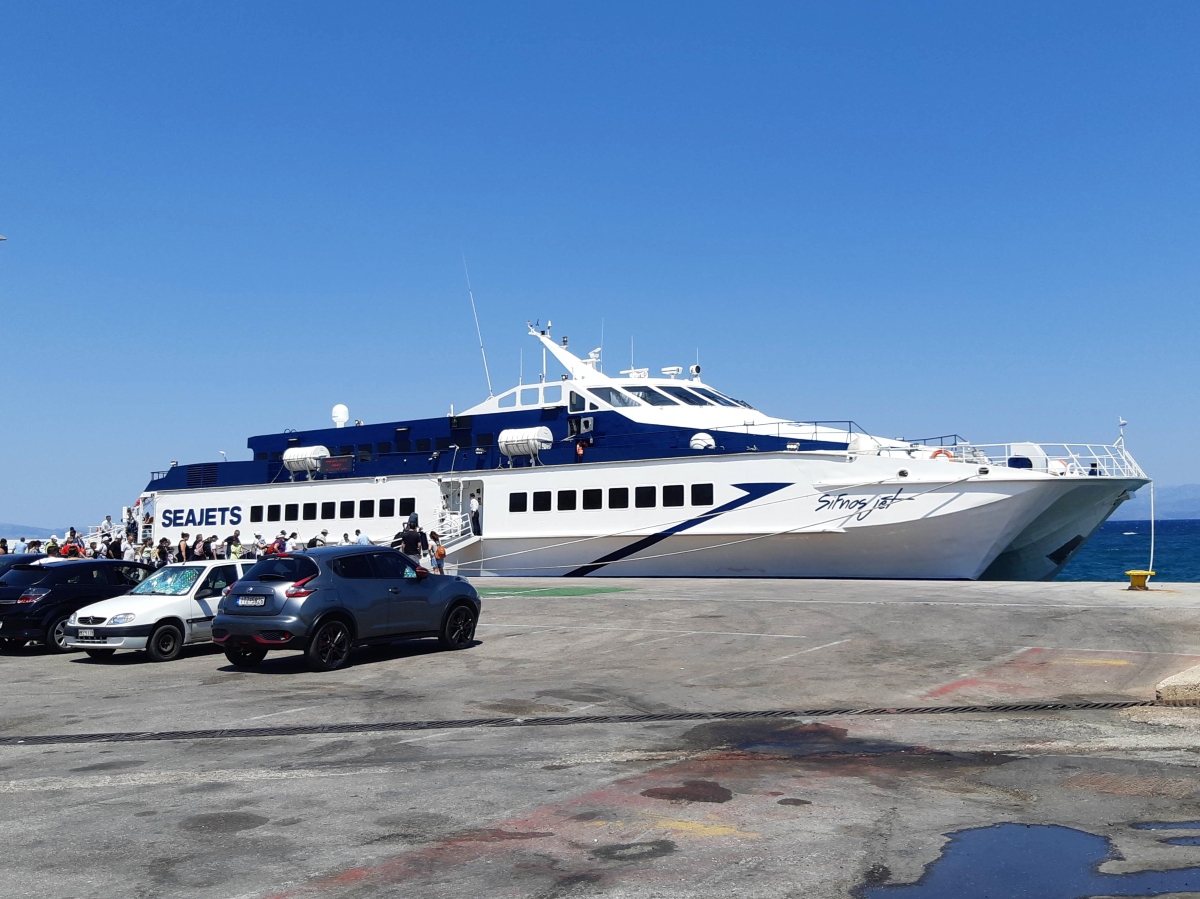
7. Choose some tours to enhance your Greek Island Experience
If you are interested in taking any organized tours on the islands you are visiting, it’s worth doing some research before you go.
You will typically find many interesting options on most islands. Some examples are sailing tours, guided tours of the ancient sites, road trips, cooking classes, and outdoor activities.
Here is a tiny selection of great tours on some of the most popular Greek islands:
- Sunset cruise in Santorini, a great way to experience the iconic island
- Guided tour of the Palace of Knossos in Crete, which was first built around 1,900 BC!
- Half-day trip from Mykonos to Ancient Delos and Rhenia – combines history, culture and amazing swimming spots
- Cooking class in Naxos island, one of my favourite Cyclades islands for food
- Amazing sailing trip in Milos, a fantastic activity where you will see the amazing coastline of Milos
- Kayaking in Rhodes – I took this myself and had a blast!
For a huge selection of tours in Greece and the rest of the world, you can check out these two platforms: GetYourGuide and Viator.
In addition to that, you can usually find last-minute sailing tours on most islands, often on smaller boats with basic facilities. Ask around at the main port town.
8. Decide how you are going to get around each island
There are several ways to get around the islands. Examples are public buses, taxis, boat trips, and walking / hiking. You will also find or rental cars, ATVs, scooters and bicycles on most islands.
Public transportation is one of the most affordable ways to get around the islands. The buses are known as KTEL buses, so you can Google the name of the island plus the phrase “KTEL bus” to find out bus itineraries. Note that these change often – there are more services in the peak season months than, for example, in April or May.
All in all, renting a vehicle will offer more freedom, and you will be able to visit places at your own pace. Discover Cars is a great website where you can easily book cars for many of the largest islands. You can also check Google Maps for car rental services on each island – just make sure you read reviews from previous customers.
Like with hotels, if you are travelling in July or August, it’s usually best to book your vehicle in advance. Have a look at this article on driving in Greece.
9. Learn a few Greek words and phrases
Learning the Greek alphabet and a couple of basic Greek phrases can enhance your island hopping experience in Greece. While English is widely spoken in tourist areas, Greeks truly appreciate it when visitors make an effort to speak Greek.
Start with the basics, like “kalimera” (good morning), and “yiassou” (hello /goodbye). Also, try to master “parakaló” (please), and “efharistó” (thank you). Unfortunately, the last one is a bit of a challenge for most people!
I’ve written three guides with a few words and phrases in Greek – have a look:
- The Greek alphabet
- Useful Greek words and phrases
- Greek curse words – use those wisely, if at all 🙂

10. How to pack for your island hopping trip
And now, let’s fast forward to a few days before your Greek island hopping trip… packing time!
When packing for your trip to Greece, keep in mind that the islands can get very hot in the summer months. Be sure to pack light, breathable clothing. However, make sure you also throw in a light jacket for those windy evenings, or the air-conditioned ferries.
Now, I can not stress it enough: Exploring the Greek islands usually involves lots of walking, and it will often seem that there are stairs wherever you go. Bring your most comfortable walking shoes, and consider packing light, as you may need to carry your suitcase up and down several flights of stairs.
You will also need a hat, sunglasses, your swimsuit, sunscreen and insect repellent. Mosquitoes in Greece are not dangerous, but they can be a nuisance… I’m talking from experience! Here’s how to avoid mosquitoes in Greece.
That said, if you forget any of those items, no worries – they are easily available all around Greece. Pharmacies, cosmetics stores and supermarkets all stock sunscreen and insect repellent, but you can also find them at many tourist shops.
Here is some more information on what to pack for Greece for every season and why I think Tevas are the best shoes for Greece.

11. Bring some cash to use on the Greek islands
These days, most businesses in Greece take credit and debit cards. However, you will still find that, sometimes, you can pay in cash only. As an example, local buses in Santorini require cash payment!
Similarly, some smaller family-run restaurants and shops in remote areas will typically prefer cash payment. In rare occasions, you might not even have the option to pay with your card.
Therefore, it’s always a good idea to carry some cash on you when you are out and about. And if you need to withdraw money, there will usually be an ATM or two in the island’s main towns.
In terms of cards, while Visa and Mastercard are both fine, note than American Express is not widely accepted in Greece.
Actually, I warmly recommend Revolut whenever you are travelling – I’ve been using it for years and it’s saved me a lot of hassle and commission fees in many countries. If you want to have a look, you can check out my referral link!
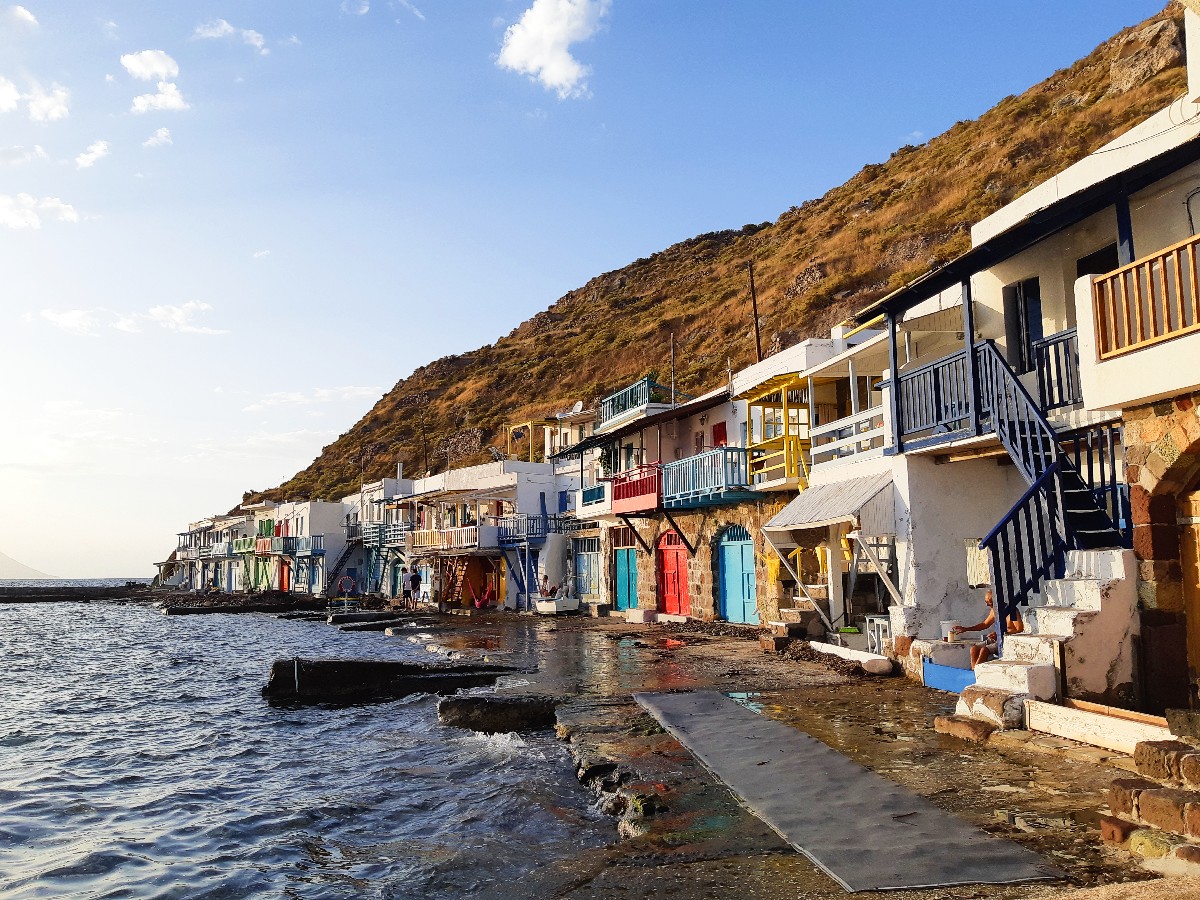
12. Embrace Greek island life!
And the big day has arrived – you are finally on one of the Greek islands! Now what?
Well! As a Greek, I can tell you that our islands are known for their relaxed and slow pace of life. Do take some time to relax on the great beaches, and take in the stunning wild beauty of the islands.
Wherever you go, you are going to want to do some sightseeing, explore the towns and traditional villages, and learn about the ancient history. But don’t forget to slow down! Take your time to embrace the Greek cuisine, and enjoy a leisurely meal with a couple of drinks at one of the Greek tavernas.
Here is my guide with 50 of the best Greek dishes!
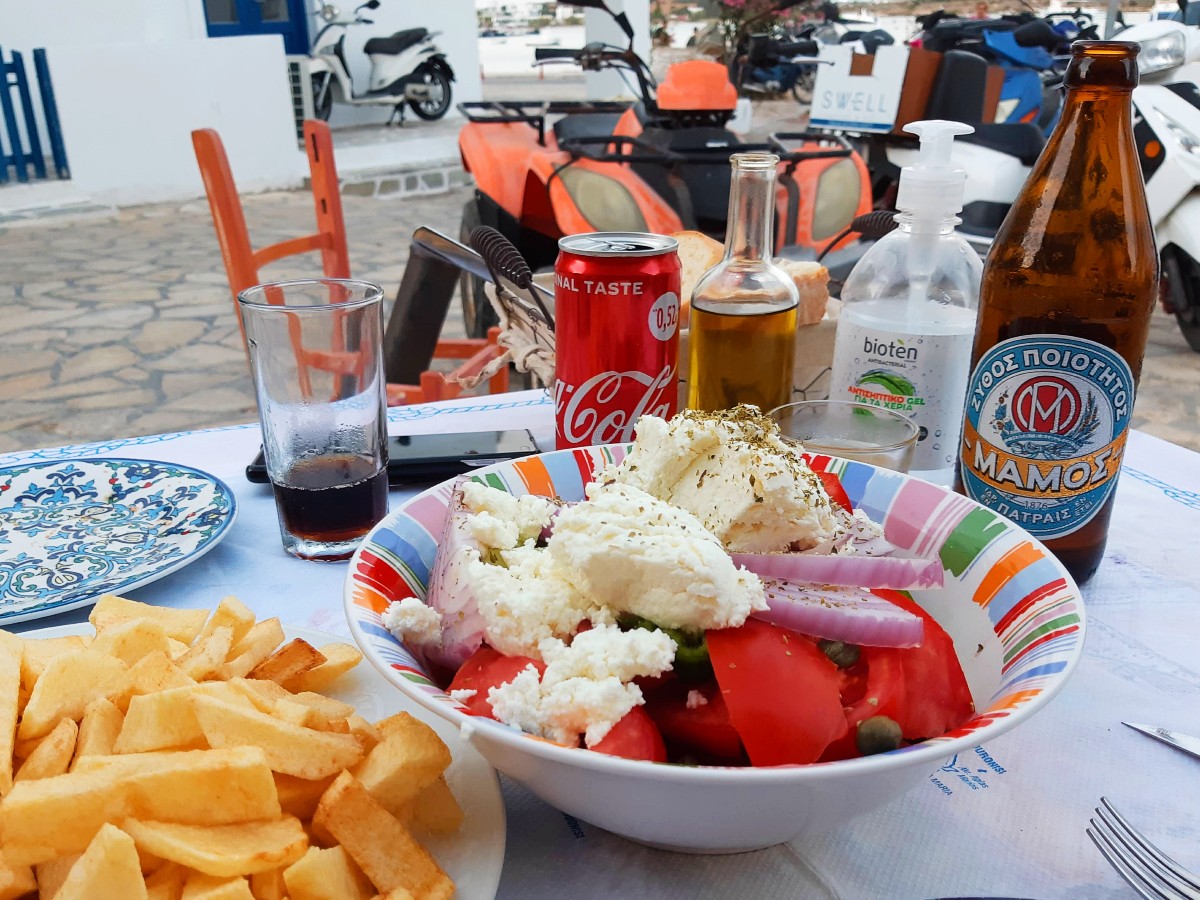
Last, but definitely not least, make sure you talk to the locals and ask about island life. I’ve always found that the conversations I’ve had with the islanders have offered me more insight about the local culture than I could ever find in any travel book or guide!
FAQs about Greek island hopping
Here are some questions that readers have asked me in the past:
Which is the best Greek island for island hopping?
You can start your Greek island hopping trip in Athens, or on any island with an international airport. Some examples are the two most famous islands in Greece, Santorini and Mykonos, which many first-time visitors include in their Greece tour. Other islands with international airports include Crete, Rhodes, Kos, Corfu, Kefalonia and Zakynthos. You can easily take a ferry from any of those to other nearby islands.
Is Greek island hopping worth it?
It is definitely worth visiting the Greek islands at least once in your life. To plan your Greek island itinerary on your own, you will need to choose the islands you want to visit, and research ferry connections between them.
When should I go Greek island hopping?
The best time of the year to travel around the Greek islands is between May and September, when the weather is warm. You will then make the most of the fantastic beaches and enjoy the local atmosphere.
How easy is Greek island hopping?
It’s actually pretty easy to plan your Greek island hopping itinerary on your own. Alternatively, you can always find some Greek island hopping packages or even sailing cruises.
What is the best way to island hop in Greece?
The best, and often the only, way to island hop in Greece is by ferry. There are several Greek island hopping routes which usually include some of the most popular islands. If you like sailing, you can also take a sailing trip around the islands.
Do you need a car for Greek island hopping?
While a car is not strictly necessary if you want to visit Greece and the Greek islands, it will offer you more freedom if you want to explore each island at your own pace. Public transportation is quite good on some of the most popular islands, but if you want to visit remote beaches or get away from areas with mass tourism, a vehicle is always a good idea.
Is Greek island hopping expensive?
Greek island hopping doesn’t need to be expensive. To keep ferry costs down, it’s better to visit fewer islands that are on the same island hopping route. Here’s some information on island hopping in Greece on a budget.
 Hi! I’m Vanessa from Athens. One of my goals is to visit all the 119 inhabited Greek islands, and I’m slowly working towards it! If you are a frequent traveller to Greece, please write any further tips you might have down below, and I’ll add them to the article. Follow me on FB and Instagram for more Greece-related inspiration!
Hi! I’m Vanessa from Athens. One of my goals is to visit all the 119 inhabited Greek islands, and I’m slowly working towards it! If you are a frequent traveller to Greece, please write any further tips you might have down below, and I’ll add them to the article. Follow me on FB and Instagram for more Greece-related inspiration!

